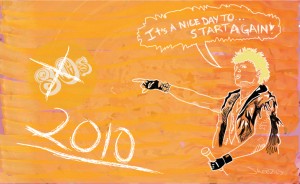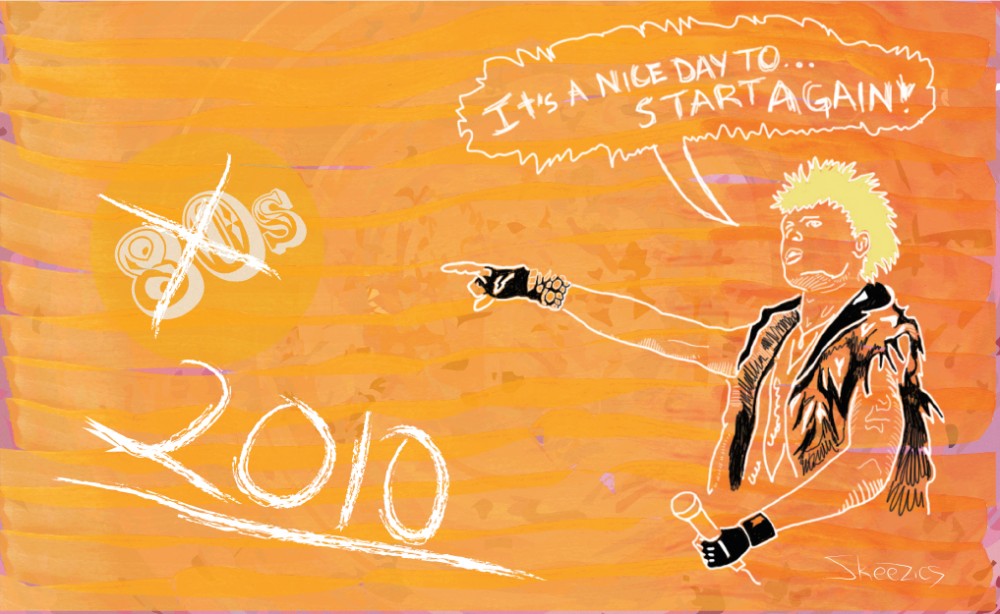Our society reflects this through Tumblrs, tweets and Toms*, three of the biggest self-obsessions of our generation. More and more of our narcissistic tendencies are being reflected in music, which time warps us back into the fantastical realm of the ’80s.

Eighties music, by and large, is about fantasy, vibrancy, and synthesizers. Musicians in the ’80s dared to go there, wherever there may be; most of them innovated, created, and collaborated until they were satisfied with their work. As this Cornell Daily Sun article argues, a large factor in ’80s music was individualism — even bands had a front person, a focal point, someone for the audience to be mesmerized by. Everything was about marketing a brand name, like Michael Jackson or Prince.
The ’90s, then, marked a turning point. Bands blew up, and groups with multiple singers in particular (Destiny’s Child, N*Sync, The Backstreet Boys, and S Club 7) became increasingly profitable. Society was interested not only in variety and cooperation, but a scaling back of the stage. Theatrics just did not interest us any more. Raw talent was more enticing than electric guitars and absurd antics. In a 1999 article, Gavin McNett suggests that the foundation for most popular (and punk) music of the ’90s was synthpop; what he couldn’t predict was that the genre would have a huge resurgence in popularity.
Our music has become more digitized and our performers have regressed to the absurdity of the ’80s. The music isn’t the same, per se — our generation draws on all kinds of resources to create music, innovating in ways we simply have not been able to before. There are parallels, though, between our generation and the ’80s that go beyond bright tights and Flashdance sweatshirts and into something deeper. These parallels highlight not only a similarity in values — a move back into the “me, me, me” mindset of the ’80s — but also a need for escapism. Perhaps we autotune everything and throw a synthesizer on it to make it less real for the consumer; we want to draw ourselves away from the reality of what we actually sound like and what the backdrop of our everyday lives are.
There has also been a trend of futurism in our generation’s music, like “Boom Boom Pow” by the Black Eyed Peas that seems to combine the escapism and glamour that we, as a society, long for.
Some music that came out of the ’80s is undeniably good, if not brilliant. Why wouldn’t we return to a time when one hit song can earn you $1 million a year for the next decade? And if you, like Madonna, are successful enough to continue earning millions throughout the decades, you can end up better off than Barbara Streisand.
Stars like Madonna, the ones who continue to permeate our media as icons of the industry, are another potential source for the reemergence of the ’80s sound and aesthetic into our lives. Most have seen the constant comparisons made about Madonna and Lady Gaga. While it is certainly true that Lady Gaga brought back the cone bra, latex, and dramatic costuming with a vengeance, as this fan shows with a tribute video to the two divas, the real commonality lies in the pop stars’ ability to push the envelope. Similarly, bands like La Roux have explored ’80s themes in order to create something altogether new (even if the inspiration is short-lived). Today’s music echoes the innovation that was key to the ’80s vibe, which, oddly enough, means that our music sometimes ends up sounding more like its from two decades ago than now.
Our music choices and options are as diverse as they have ever been. We can be simultaneously attracted to multiple genres and feed our musical addictions through sites like YouTube, which act as a modern-day MTV to tell people the latest pop culture news. While music constantly evolves, in some ways it is also regresses, like taking an old pair of shoes and fixing them with duck tape so they are completely wearable (and fit great). America is a country that constantly innovates, but as we find ourselves more drawn to fantastical and enchanting music, aesthetics and other aspects of material culture, we have to admit it: we’re gluttons for glamour.


One Comment on “Gluttons for Glamour: How Re-Inventing 80s Music Satisfies America’s Self-Absorbed Addiction”